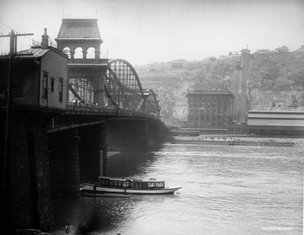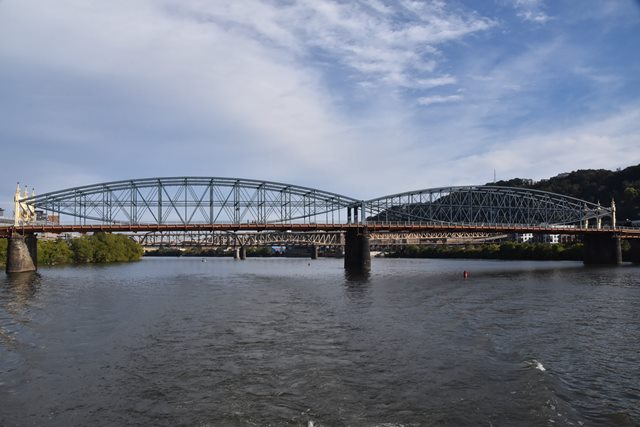We Recommend:
Bach Steel - Experts at historic truss bridge restoration.
Smithfield Street Bridge

Primary Photographer(s): Nathan Holth and Rick McOmber
Bridge Documented: June, 2004 - October 2, 2021
Pittsburgh: Allegheny County, Pennsylvania: United States
Metal 13 Panel Pin-Connected Lenticular Through Truss, Fixed and Approach Spans: Metal Rivet-Connected Polygonal Warren Pony Truss, Fixed
1883 By Builder/Contractor: Andrew Kloman and Engineer/Design: Gustav Lindenthal
1994
360.0 Feet (109.7 Meters)
1,177.0 Feet (358.7 Meters)
42 Feet (12.8 Meters)
1 Main Span(s) and 6 Approach Span(s)
23027002000000

View Information About HSR Ratings
Bridge Documentation
View Archived National Bridge Inventory Report - Has Additional Details and Evaluation
View Historic American Engineering Record (HAER) Documentation For This Bridge
HAER Data Pages, PDF - HAER Original Plan Sheets, PDF
View Historical 1933 Article About This Bridge's Aluminium Deck Project
This is arguably Pittsburgh's most important historic bridge. It has five commemorative plaques on it, including one listing it as a National Historic Landmark, which is the highest and rarest honor the United States can bestow upon a bridge!
This bridge appears to be the only surviving example of a lenticular truss that is not associated with The Berlin Iron Bridge Company or its predecessor the Corrugated Metal Company, which held patents on a lenticular truss design. The Historic American Engineering Record instead points to a much earlier patent by Edwin Stanley which shows a similar truss configuration, as the inspiration for the design of the Smithfield Street Bridge. With its two 360 foot spans, the Smithfield Street Bridge displays the longest lenticular truss spans known to remain in the United States. Compare this to the otherwise large 198 foot span of the Bardwells Ferry Bridge. The Smithfield Street Bridge is also noted for being one of the first bridges in the United States to use steel in its trusses as opposed to exclusively wrought and cast iron.

The bridge was originally built in 1881-1883 as two truss lines wide, but in 1889-1890 a third truss line was added to widen the bridge. In 1911, it was widened by a much smaller amount, and one of the trusses was simply moved over. Shortly after this time as part of the project, the original cast iron portals were replaced with the ones seen today in 1915. A some later date, the approach spans were reconfigured, and today a riveted pony truss span is part of the southern approach.
As one might imagine, for a bridge that was altered so much in its early life, and further has remained functioning in a major city in the 21st Century, the Smithfield Street Bridge has been significantly altered from its original design. The earlier alterations can be dismissed since they are so old and were done early enough in the history of the bridge that these alterations are themselves historic. However, there are numerous modern alterations including rivets replaced with bolts, welded steel added to various parts of the bridge, concrete fill added to the center end posts, and missing original railings. These alterations have diminished the historic integrity of the bridge, however the bridge retains enough of integrity of materials and design to maintain an extremely high level of historic and technological significance. In addition, historical photos of the bridge show the original sidewalk railings on the bridge which were extremely ornate, far more beautiful than the utilitarian railings present today. There are some railings along some of the streets near to the southern approach of the Smithfield Street Bridge that look suspiciously like the railings seen on the bridge in 1883. This railing is shown to the left. These railings are similar, albeit different to the original railings. It would be nice to see Pittsburgh replace the current railings with replicas of the original railing. Chicago is another city that has in recent years replaced non-original railings on its bridges with replicas of the ornate originals. There is no reason why Pittsburgh could not do the same.
The bridge's bottom chord eyebars have, like much of the bridge, been significantly altered over the bridge's long and colorful history. Unfortunately a decision to weld plate onto the surface of the eyebars had the highly unfortunate effect of covering up an important piece of history on the bridge. Only some of the eyebars escaped alteration. On those, a label is visible. Shown in the picture to the left, it reads Kloman Patent Process 1881. Andrew Kloman was the owner of a local mill in the Homestead area that produced a variety of iron and steel. Kloman held several patents, one of which related specifically to the fabrication of up-set eyebars, which is the patent that the marks on the Smithfield Street Bridge's eyebars refer to. Kloman and his mills would later become associated with the famous Carnegie Steel Company. Because these labels on the eyebars are important for interpreting the history of the Smithfield Street Bridge, any future repairs to the bridge should take into account the significance of these labels, and should not hide or cover up these surviving markings.
Some claims have been made or may have been made about the Smithfield Street Bridge which are not true or are disputed. The bridge is not the oldest metal truss in the country, since the Reading Hall Station Bridge is decades older, nor even the oldest steel truss in the country, since the 1879 Glasgow Railroad Bridge is older. The bridge is sometimes called a "Pauli" truss, the definition of which is not agreed upon according to this article (PDF version).
Above: These photos show the bridge after it was widened but before the new portal bracing was installed. Source: Library of Congress
Additional Resources
View The National Register Nomination Form For This Historic Bridge
View Historical Article About The Portal Bracing Replacement
View Andrew Kloman Patents: 164379, 188741, 244811
View Edwin Stanley Lenticular Truss Patent
View A Detailed Historical Article About This Bridge By Its Engineer Gustav Lindenthal
View The 1903 Inside History of the Carnegie Steel Company, Which Discusses Andrew Kloman
View A Eulogy For Andrew Kloman, Which Discusses His Life In Detail
This bridge is tagged with the following special condition(s): Unorganized Photos
![]()
Photo Galleries and Videos: Smithfield Street Bridge
Structure Overview
Original / Full Size PhotosA collection of overview photos that show the bridge as a whole and general areas of the bridge. This gallery offers photos in the highest available resolution and file size in a touch-friendly popup viewer.
Alternatively, Browse Without Using Viewer
![]()
Structure Details
Original / Full Size PhotosA collection of detail photos that document the parts, construction, and condition of the bridge. This gallery offers photos in the highest available resolution and file size in a touch-friendly popup viewer.
Alternatively, Browse Without Using Viewer
![]()
Structure Overview
Mobile Optimized PhotosA collection of overview photos that show the bridge as a whole and general areas of the bridge. This gallery features data-friendly, fast-loading photos in a touch-friendly popup viewer.
Alternatively, Browse Without Using Viewer
![]()
Structure Details
Mobile Optimized PhotosA collection of detail photos that document the parts, construction, and condition of the bridge. This gallery features data-friendly, fast-loading photos in a touch-friendly popup viewer.
Alternatively, Browse Without Using Viewer
![]()
Additional Unorganized Photos
Original / Full Size PhotosA supplemental collection of photos that are from additional visit(s) to the bridge and have not been organized or captioned. This gallery offers photos in the highest available resolution and file size in a touch-friendly popup viewer.
Alternatively, Browse Without Using Viewer
![]()
Additional Unorganized Photos
Mobile Optimized PhotosA supplemental collection of photos that are from additional visit(s) to the bridge and have not been organized or captioned. This gallery features data-friendly, fast-loading photos in a touch-friendly popup viewer.
Alternatively, Browse Without Using Viewer
![]()
Maps and Links: Smithfield Street Bridge
Coordinates (Latitude, Longitude):
Search For Additional Bridge Listings:
Bridgehunter.com: View listed bridges within 0.5 miles (0.8 kilometers) of this bridge.
Bridgehunter.com: View listed bridges within 10 miles (16 kilometers) of this bridge.
Additional Maps:
Google Streetview (If Available)
GeoHack (Additional Links and Coordinates)
Apple Maps (Via DuckDuckGo Search)
Apple Maps (Apple devices only)
Android: Open Location In Your Map or GPS App
Flickr Gallery (Find Nearby Photos)
Wikimedia Commons (Find Nearby Photos)
Directions Via Sygic For Android
Directions Via Sygic For iOS and Android Dolphin Browser
USGS National Map (United States Only)
Historical USGS Topo Maps (United States Only)
Historic Aerials (United States Only)
CalTopo Maps (United States Only)














